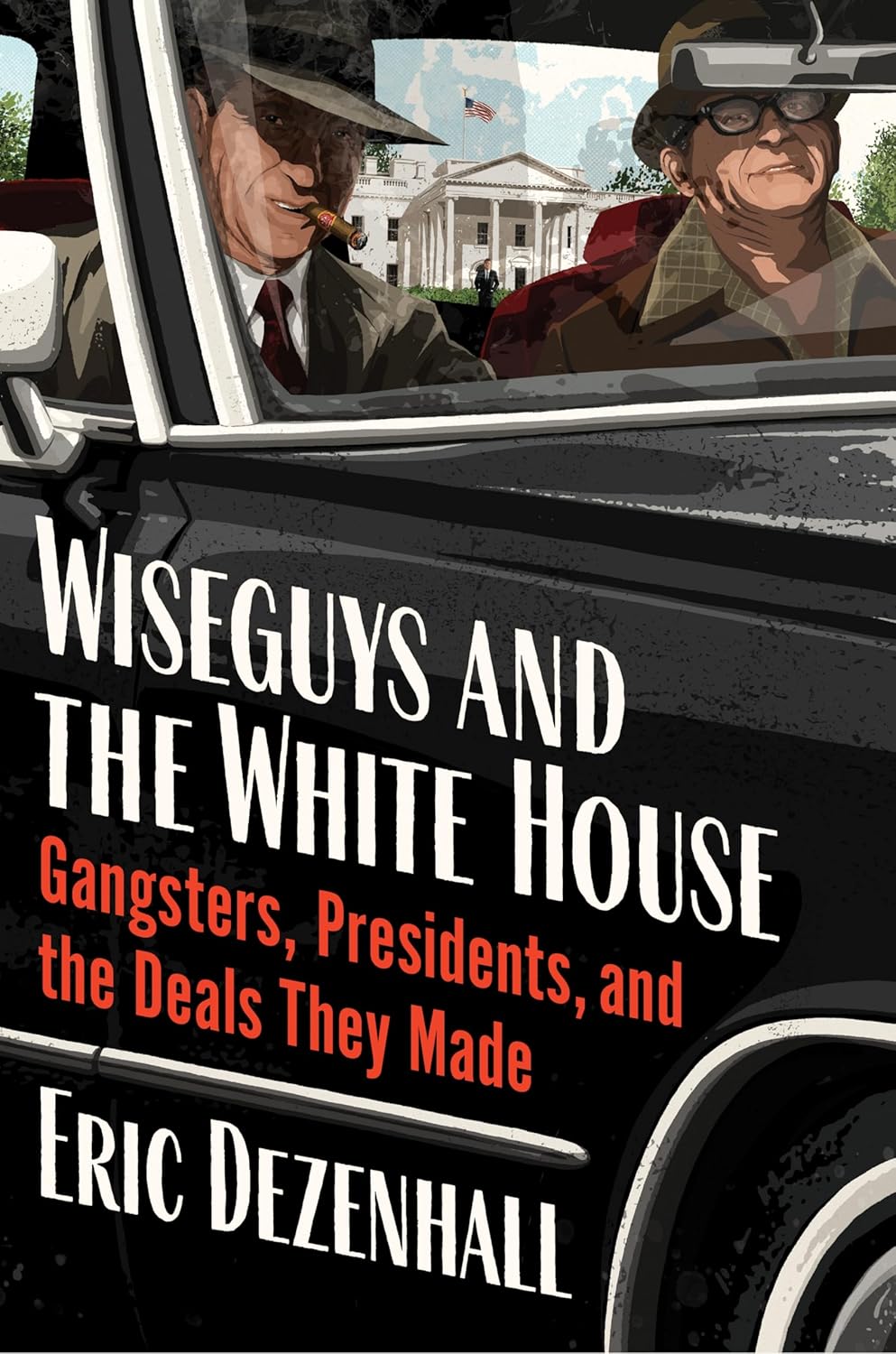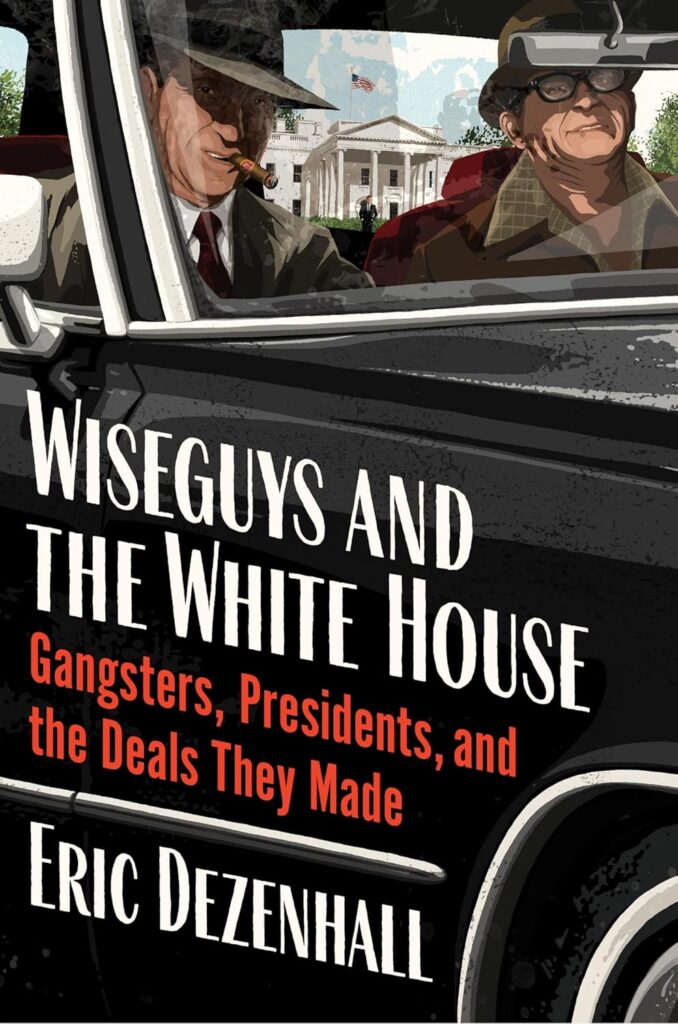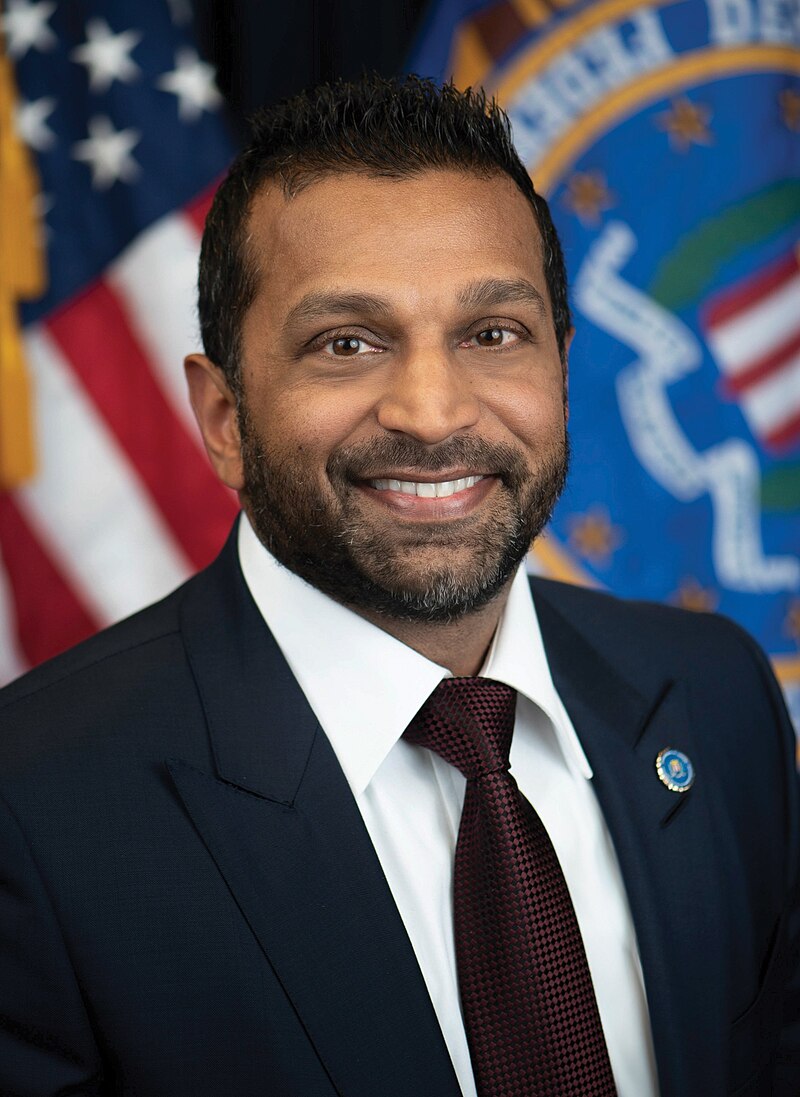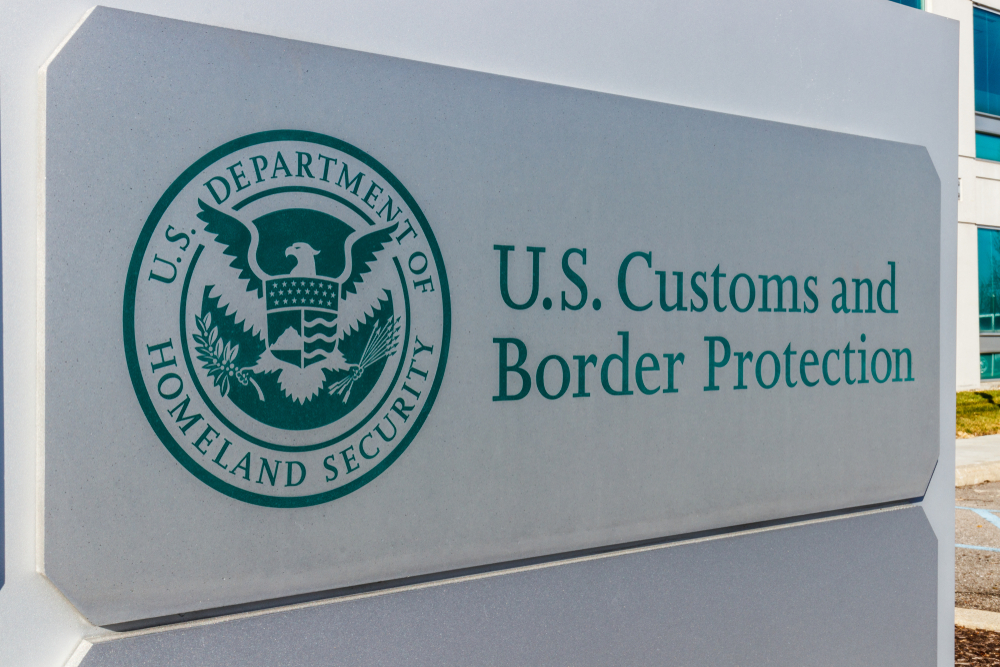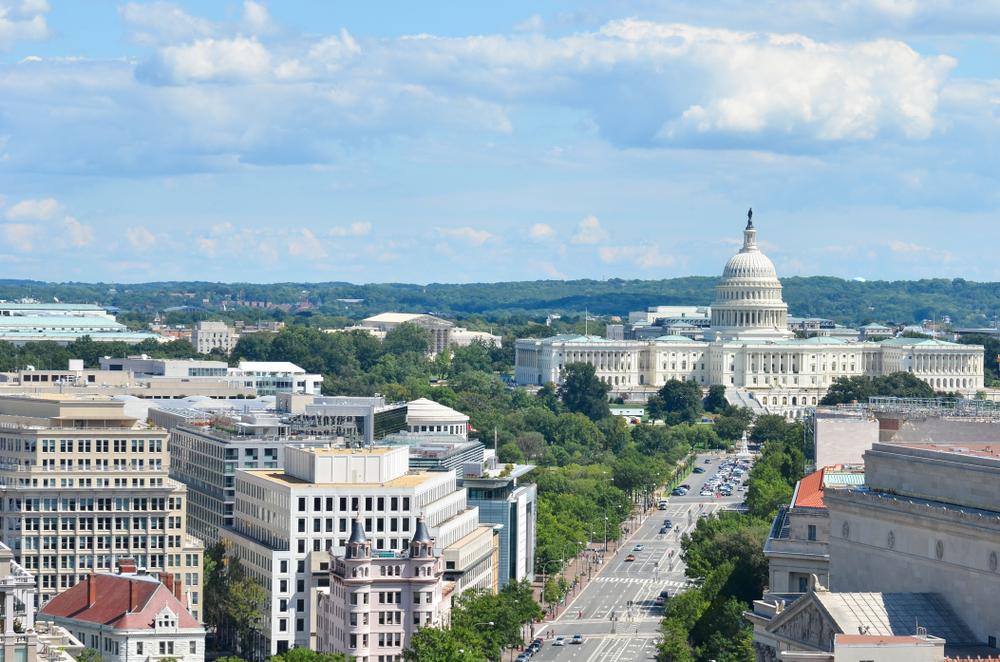The author is an award-winning author of twelve books of fiction and nonfiction. Published by HarperCollins, the book, “Wise Guys and the White House — Gangsters, Presidents, and the Deals They Made,” goes on sale Tuesday. The excerpt is being published with permission.
By Eric Dezenhall
J. EDGAR HOOVER AND THE GIFT OF COMMUNISM
Prohibition catalyzed the mob, and labor racketeering institutionalized American gangsterism. Still, something bigger allowed it to grow practically unchecked into the behemoth it became: the diversion of resources by the federal government and especially the FBI toward catching suspected Communists versus enterprise criminals.
Going after Communists was a low-risk/high-reward endeavor, especially for men like Nixon and Hoover. Nixon had built his career on the foundation of anti- Communism, which was very effective. Hoover kept his job for almost a half century by pivoting from catching bank robbers to nailing Communists while building the world’s most advanced law enforcement organization.
Communism was the best thing to have happened to the mob after Prohibition ended. Hoover’s natural mindset, strategic outlook, and bureaucratic instincts were the reasons he had given the Mafia short shrift. It was a by-product, not a conspiracy, on Hoover’s part. He is the ]one individual who runs through many of the presidents addressed in this book. To understand why the mob flourished during the Hoover years, it’s essential to understand that Hoover’s pursuit of communists was rooted in genuine concern about threats to the United States as opposed to a subjective fetish.
In a peculiar sideshow during the mid to late 1960s, Hoover tried to use the mob to harass Communists through a scheme called Operation Hoodwink. The gist was to convince mobsters that
Communists were a threat to their labor rackets so the gangsters would disrupt their activities. These Philadelphia- focused efforts were accomplished by forging letters purportedly from CPUSA officials to mob- connected labor leaders threatening to turn them in to law enforcement.
Hoodwink was disbanded in 1968 for lack of tangible results.
One of the Soviets’ most remarkable achievements was propaganda, especially turning a new generation of Americans against their government by fanning racial divisions and publicizing the U.S. government’s abuses. A brilliant subset of this effort was persuading many that the very suggestion that there was a Communist influence in our government and culture was
irrational and, perhaps worse, culturally uncool.
There had been justifiable strategic reasons for Hoover to pursue Communists even if he overestimated the threat and his tactics were overzealous and, in some cases, criminal. Furthermore, his anticommunist views were in the mainstream of American political thought and embraced by multiple presidents.
What these leaders had in common as the twentieth century wore on was a terror of nuclear war. In research for a previous book, the one thing that FBI, CIA, and KGB agents interviewed agreed upon was that the spy game was driven by fear of a nuclear exchange. Hoover’s concern was that a bomb would be smuggled into the United States by a Communist fellow traveler and planted in a major city. He and other officials believed these comrades would come in the form of American radicals such as Julius and Ethel Rosenberg in the early days of the Cold War and, later, activist Angela Davis, who received an honorary doctorate from Moscow State University, won the Lenin Peace Prize, and openly praised the Soviet Union. These views intensified with the rise of Martin Luther King, Jr., and the civil rights movement. FBI honcho William Sullivan disturbingly wrote of Martin Luther King, Jr., “We must mark him now, if we have not done so before, as the most dangerous Negro of the future in this Nation from the standpoint of communism, the Negro and national security.”
During Hoover’s reign, his FBI discovered and prosecuted espionage rings that had been passing along nuclear secrets to the Soviets, including the Rosenbergs and Ethel’s brother David Greenglass, and physicists Klaus Fuchs and Theodore Hall. In the late 1930s and early 1940s, the FBI captured and helped convict two German spy rings (not including the Long Island and Florida Nazi submarine spies addressed in the Roosevelt chapter). In concert with the Army Signal Corps, the FBI helped identify 350 operatives in the United States who were providing the Soviets with valuable intelligence. It is believed that the FBI was able to eliminate most Soviet moles within the government through the mid-1950s.
No less than a vice president of the United States, secretary of commerce, and secretary of agriculture in the form of Henry Wallace had been a Soviet asset. Even ultraliberal writer and critic Dorothy Parker thought Wallace a Soviet stooge. Historian John Lewis Gaddis wrote, “There is
Soviet documentation that Wallace was regularly reporting to the Kremlin in 1945 and 1946 while he was in the Truman Administration.”
Ohio senator Robert Taft said: “The greatest Kremlin asset in our history has been the pro-communist group in the State Department who surrendered to every demand of Russia at Yalta and Potsdam, and promoted at every opportunity the communist cause in China until today communism threatens to take over all of Asia.”
The New York Times journalist Walter Duranty, one of the most influential reporters of his era, was a pro-Soviet propagandist. He consistently downplayed Joseph Stalin’s genocidal methodology and orchestrated famines.
Hoover authorized break-ins at Soviet and Eastern Bloc offices based in U.S. cities, efforts that presidents and attorneys general approved. He provided Senator Joseph McCarthy with reports on suspected Communists, which McCarthy cited, with creative flourishes. In 1958, Hoover pub-
lished a ghostwritten book, Masters of Deceit, which became a bestseller and focused on the Communist threat to America. Deceit earned today’s equivalent of $500,000, which Hoover kept personally.
There had been a spiritual component to Hoover’s zeal. He told a reporter: “I’ve been studying [Communism] since 1919. It is really not so much a political creed as an insane kind of fanaticism, a fanaticism that is basically atheistic—anti-God, if you like—and against the concept of any supreme being.”
According to the FBI:In the six years following World War II, the Bureau had moved from having a shadowy perception of the Soviet intelligence threat to having a clear picture of the extent of Soviet penetration of the U.S. government and the damage that its agents had done to America’s interests.
With this vastly clearer image of the threat we faced, the FBI was able to move from a reactive counterintelligence policy to a proactive one. . . .By October 1951, the Bureau had initiated a program of intensive cover- age of Soviet and Satellite personnel and establishments to thwart Soviet intelligence efforts and those by its allies . . . this program included intensive electronic surveillance, a long-term effort to develop double agents within hostile intelligence establishments, and an effort to develop other double agents to flush out hostile intelligence personnel.
No less than Vladimir Putin has bragged that Soviet agents stole nuclear secrets from U.S. scientists. Said Putin to the Itar-Tass news service:
“You know, when the States already had nuclear weapons and the Soviet Union was only building them, we got a significant amount of information through Soviet foreign intelligence channels. It was the cream of the scientific world that was gathered in America, and I personally have
- (Footnote) Indeed, Communism was not just the obsession of federal operatives like
Hoover but of evangelical leaders such as the Reverend Billy Graham, who grew
his flock on radio and television in part by relentlessly hammering the idea that
Communism was the work of Satan and could only be countermanded by the
Christian faith. All self-justifying entities need a hardened villain.
gotten the impression that they consciously gave us information on the atom bomb.”
THE SUBVERSION DIVERSION
It’s telling that in the late 1950s, at the height of the Cold War, the New York office of the FBI had four hundred agents hunting Communists and other “subversives” and four keeping an eye on the rackets, the latter because Hoover believed gangsters were the purview of the New York Police
Department. Beginning in the late 1950s, Hoover’s COINTELPRO (counterintelligence program) effort to disrupt Communist sympathizers ran more than twenty-three hundred operations against suspected subversives. It was here that Hoover’s efforts lost their bearings. He had 300,000
pages of files on likely homosexuals because he believed they were uniquely vulnerable to Communist influence.
The FBI collected files on college students making observations ranging from “an inveterate Marxist revolutionist” to an “average liberal-minded student.” The FBI would show these files to university leaders with the hope that they would crack down on campus free speech. The FBI also arranged for the Internal Revenue Service to audit specific targets and forged correspondence to turn cell leaders against one another.
It didn’t work. Yet organized crime galloped on apace until the FBI began taking it seriously, the efforts catalyzing after Hoover’s death.
Going light on organized crime was a by-product of a diversion of focus and resources, not corruption. This worked out beautifully for the mob, but only a tiny portion of this outcome had anything to do with their cleverness. Hoover and American political leaders had written off organized crime as a local priority. Hoover had linked the civil rights movement to national Communist infiltration, whipping up racial unrest as a desire to tear the country apart from within. There was an element of Soviet “active measures” at work, but this ignores the real injustices
animating the push for civil rights.
Nevertheless, Hoover should have recognized earlier that there had been national implications to gangland’s reach and that the FBI had the greatest capability to have met this challenge. The by-product was to unfetter a network of enterprise criminals who ran operations that did billions of
dollars in business annually. One can only wonder what the impact would have been had the FBI directed its wrath against organized crime sooner.
Qualified sociologist Daniel Bell: “Unfortunately for a good story—and the existence of the Mafia would be a whale of a story—neither the Senate Crime Committee in its testimony nor Kefauver in his book presented any real evidence that the Mafia exists as a functioning organization.”
Technically, Hoover hadn’t been wrong to see organized crime as a local phenomenon. There were twenty-four local mobs. Gangsters liked this model because had they been perceived as a national enterprise, they would have become attractive to the feds, and the last thing they wanted
was to be interesting. When LCN oozed onto the national radar, bosses admonished their hoods not to cross state lines or perform bank robberies, a federal crime, because they hadn’t wanted to awaken Washington. They were sensitive to the investigative power of national agencies (besides the FBI) hunting down narcotics, tax evaders, and counterfeiters and had been prosecuting LCN members since the early 1900s. Many in Congress shared Hoover’s view that federal budgeting hadn’t been needed for local crimes.
An FBI agent put it somewhat differently, stating that the bureau could only investigate under the laws that existed, not the laws it wanted to exist.
LCN could coordinate with multiple cities when needed, primarily to defuse conflicts. The problem was proving it, an endeavor promising too little investment return. This was complicated by another fortuitous reason the mob got a break after Bobby Kennedy died: His successor, Ramsay Clark, disapproved of electronic surveillance, believing it was a slippery slope toward a mass violation of civil liberties. Yet another bureaucratic development may have slowed Hoover’s pursuit of the mob.
As attorney general, Bobby Kennedy had proposed the formation of a crime commission to supplement the FBI’s efforts. Hoover hadn’t wanted the competition. Then there was Kefauver, whom Hoover had little interest in helping. For Hoover to retain power, he needed to be the only national crime czar. Kennedy’s commission idea quickly faded.
Said biographer Gage: “Whatever was said at the meeting [between RFK and Hoover], in the following weeks Bobby’s enthusiasm for the commission dropped markedly, while his public praise of Hoover notably increased.”
“THAT LICENSE”
While it had been shrewd of Hoover to duck the mob, it was against the country’s best interests to allow the rackets to go unchallenged for so long. Wrote organized crime expert Thomas Reppetto, “It [the FBI] could have argued that the activities of the Mafia constituted a clear and present
danger to national security, citing, for example the Teamsters’ ability to paralyze transportation.”
Hoover only accelerated his war on the mob after the disastrous Apalachin conference in 1957, when he had to. A document unearthed decades after his death confirms that Hoover eventually realized he had been wrong about not having devoted more to the mob than he had. In 1970, a colleague was circulating a new book by Ed Reid called The Grim Reapers. As organized crime legal scholar Alex Hortis reported, Hoover sent back the cover note that came with the book with a scrawl reading:
“I have in mind that I was originally advised by Rosen that the Mafia or anything like it in character never existed in this country. I have been plagued ever since for having denied its existence.”
Hortis concluded that Hoover “simply may have underestimated the Mafia. Ironically, the FBI came to understand organized crime better than any agency.”
THE HOOVER BLACKMAIL THEORY
There have been claims by conspiracy theorists that Hoover was in the mob’s pocket and even received horse racing tips about fixed races from Frank Costello. In reality, Costello feared Hoover, having called him a “professional blackmailer.” This theory, of course, is a lot of fun. Still, outside of internet obsessives and sensational authors, there’s no evidence that it’s true.
The most sensational Hoover theory was that the FBI director was gay and that Meyer Lansky, the mastermind of first resort, kept a photo of Hoover in a compromising position in his well-guarded private records.
There are a few problems with this theory. First, the primary source for this was an unstable, bitter divorcée who had been paid for her testimony and had served time in prison for perjury. She was the estranged wife of liquor mogul Lewis Rosenstiel and claimed to have seen Hoover at a cocktail
party wearing a fluffy dress, identifying himself as “Mary.” Hilarious and vivid but preposterous. Wrote historian David K. Johnson (no relation to Trump chronicler David Cay Johnston): “Given the near hysteria in 1950s Washington about the threat posed to national security by homosexuals
in high government office, the existence of so much evidence of Hoover’s sexuality would have led to his ouster.”
Even if Hoover had been gay, a man so obsessed with his image would not be parading around Georgetown parties in a chiffon gown, however stunning he may have looked. One would think that kind of thing could get around. As journalist Frank Rich opined, “There is no solid proof for the transvestism charges leveled against J. Edgar Hoover, but we can dream, can’t we?” Hoover’s alleged cross-dressing remains pop-culture gold, featured in TV shows like Seinfeld and Saturday Night Live.
I have reviewed Lansky’s most private documents and personal financial records, and there was nary a Hoover centerfold to be found. Might Lansky not have leveraged this photo when Hoover virtually chased him out of the country in 1970? Wouldn’t Lansky’s family, some acutely cash-
strapped after his death, have put the sexy Hoover pic on the open market in the last half century? After all, some family members sell swaths of cloth from Lansky’s suits online.
Hoover’s FBI not only prosecuted Lansky, but the Justice Department that employed him formed the only one-man-target strike force at that time, Project Financier. Hoover even called for a “crash investigation” of Lansky, according to FBI records. Lansky had his version of a last laugh, observing to an Israeli official, “Attorney General Mitchell who since then has been convicted of a felony, is at present in jail” and in an interview, “I’m free, but look who’s in jail now. Mitchell.”
Lansky’s partner Jimmy Alo put it best when asked about the Hoover photo: “There was never no such picture. If there was, I’d have known about it, being so close to Meyer.” Approaching a century of life, with Hoover dead for decades, Alo had no reason to lie.
Still, lesser mobsters than Alo cherish the Hoover-in-a-dress meme because it’s a cheap and self-aggrandizing proxy battle: See what happens when you mess with us! We even control the federal government! As the 1960s wore on, Hoover stepped up surveillance, not to mention outright harassment of key mob figures, whether he had the goods on them or not.
In The Godfather, when the aging Don speaks to Michael in the garden about their failure to have become senators and governors, Michael scoffs, “Another pezzonovante,” which roughly means “big shot.” Almost everyone misses this critical point of the movie: Even Don Corleone didn’t
think he had become a big shot, thus the obsessive push toward legitimacy with “the
move to Nevada.”
Some of the smarter retired mobsters combine nostalgia with remarkable candor and insight.
Sammy Gravano shared a story about John Gotti’s suggestion while incarcerated about bribing President Bill Clinton to pardon them. Gravano was dumbfounded by Gotti’s brainstorm and
suggested that breaking out of their eleventh-floor prison cell was a better idea because that was something they, as criminals, might know how to do: “He’s the President of the United States! He wants $5 million, he needs it from us? And he’s gonna release me and you for multiple murders, give us a pardon for what reason? ’Cause we gave him $5 million? He’s not gonna
make that public. That’s insane. I’m goin’ out the window. You can bribe the president. I wish you all the luck in the world.”
For all its bad-boy mystique, the Mafia thrived during earlier times because it knew its place in the shadows. In addition to not provoking the federal government, they preferred not to stir trouble with other groups.
Someone close to my family once owned the heavyweight boxer Sonny Liston’s contract. I asked him if LCN ever got it hands on Muhammad Ali, who lived in our town. He said, “Hell, no, we didn’t want to tangle with the bow ties,” meaning the Nation of Islam, which guided Ali’s career.

